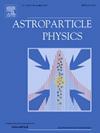por - sr康普顿望远镜CdTe-Timepix3探测器模块偏振性评价
IF 2.9
3区 物理与天体物理
Q1 ASTRONOMY & ASTROPHYSICS
引用次数: 0
摘要
亚兆电子伏至低兆电子伏波段的伽玛射线偏振测量是一个尚未开发的领域,需要开发利用新型空间仪器的偏振计,该仪器具有增强的定时、成像和偏振能力,此外还有强大的光谱响应。THOR-SR是一项天体物理技术演示,将在欧洲航天局的太空骑士号上执行为期两个月的任务。主要仪器是由四层组成的全天康普顿望远镜,每层有四个基于2.0 mm厚CdTe-Timepix3探测器的模块。在此,我们评估了2.0 mm厚的256 × 256像素CdTe-Timepix3探测器(55 μm像素尺寸,1.98 cm²敏感区域,并采用Timepix3芯片)的偏振性能。对于能量在100 ~ 300 keV的100%线极化伽玛射线束,我们探索了一种基于康普顿散射运动学的康普顿事件重建方法。通过选择过程,我们研究了影响散射伽马射线方位角分布统计的几个经验因素。然后,我们给出了对非极化和极化伽马射线的响应,包括具有非常接近偏振角的光束。最后,给出了在蟹状天体观测中对THOR-SR望远镜偏振灵敏度的估计。CdTe- timepix3探测器的特点使其作为一个优良的康普顿偏振计,确保高调制因子≈0.6和康普顿检测效率显著高于其他2.0 mm厚像素化CdTe/CZT偏振计。该实验室偏振计具有亚度的角灵敏度,能够区分<;1.0°的偏振角,剩余统计偏振分数≈0.03。最小可探测偏振<;0.3预计在20天的螃蟹观测与索尔- sr康普顿望远镜。本文章由计算机程序翻译,如有差异,请以英文原文为准。
Polarimetric evaluation of CdTe-Timepix3 detector module for THOR-SR Compton telescope
Gamma-ray polarimetry for the sub-MeV to lower-MeV band, an unexplored regime, requires the development of polarimeters that utilize novel space instrumentation with enhanced timing, imaging, and polarimetric capabilities, in addition to a robust spectroscopic response. THOR-SR is an astrophysics technology demonstrator to fly aboard the ESA vehicle Space Rider on a two-month mission. The main instrument is an all-sky Compton telescope composed of four layers, each layer with four modules based on 2.0 mm thick CdTe-Timepix3 detectors.
Herein, we evaluate the polarimetric performance of a 2.0 mm thick CdTe-Timepix3 detector with 256 × 256 pixels (55 μm pixel size, 1.98 cm² sensitive area, and featuring the Timepix3 chip). For gamma-ray beams, 100 % linearly polarized with energies within 100−300 keV, we explored a method for reconstructing Compton events based on Compton scattering kinematics. Using a selection process, we examined several empirical factors that influence the statistics in the azimuthal angular distribution of scattered gamma rays. Then, we present the response to unpolarized and polarized gamma rays, including beams with very close polarization angles. Finally, an estimate of the THOR-SR telescope's polarization sensitivity in Crab observations is presented.
The features of the CdTe-Timepix3 detector enable its operation as a fine Compton polarimeter, ensuring high modulation factors of ≈0.6 and a significantly greater Compton detection efficiency compared to other 2.0 mm thick pixelated CdTe/CZT polarimeters. The laboratory polarimeter exhibits a sub-degree angular sensitivity, capable of distinguishing polarization angles separated by <1.0°, and reveals a residual statistical polarization fraction of ≈0.03. Minimum detectable polarization <0.3 is foreseen in 20-day Crab observations with the THOR-SR Compton telescope.
求助全文
通过发布文献求助,成功后即可免费获取论文全文。
去求助
来源期刊

Astroparticle Physics
地学天文-天文与天体物理
CiteScore
8.00
自引率
2.90%
发文量
41
审稿时长
79 days
期刊介绍:
Astroparticle Physics publishes experimental and theoretical research papers in the interacting fields of Cosmic Ray Physics, Astronomy and Astrophysics, Cosmology and Particle Physics focusing on new developments in the following areas: High-energy cosmic-ray physics and astrophysics; Particle cosmology; Particle astrophysics; Related astrophysics: supernova, AGN, cosmic abundances, dark matter etc.; Gravitational waves; High-energy, VHE and UHE gamma-ray astronomy; High- and low-energy neutrino astronomy; Instrumentation and detector developments related to the above-mentioned fields.
 求助内容:
求助内容: 应助结果提醒方式:
应助结果提醒方式:


